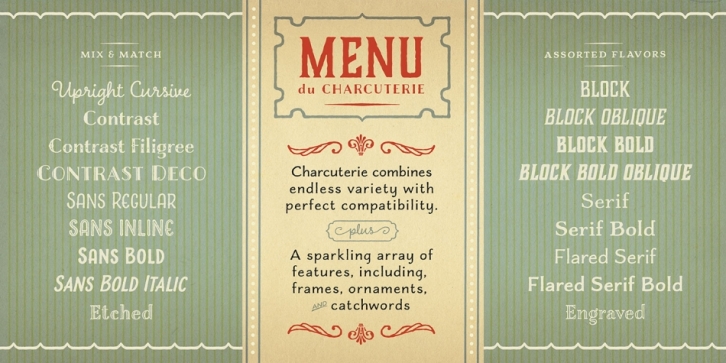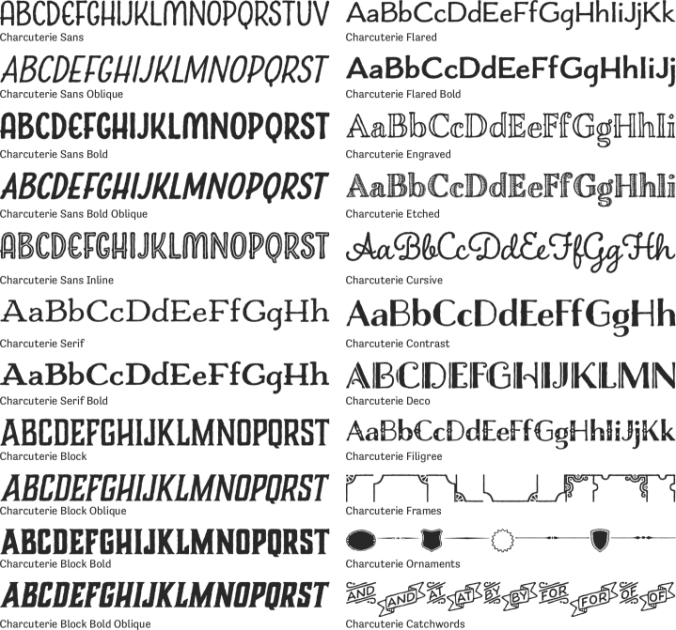


 Charcuterie is a multiple category font style collection published by Laura Worthington.
Charcuterie is a multiple category font style collection published by Laura Worthington.A large and unusual endeavor, Charcuterie is a household of 10 distinct yet associated typefaces, much of which have their own font households, and three decorative/ornamental typefaces.
While most of the Charcuterie typefaces are equipped with a basic character set, Charcuterie Engraved features 135 swash alternates and Charcuterie Cursive boasts 275.
Charcuterie Frames uses a broad and unlimited method to developing frames of any width, height and style. Featuring 60 corner aspects and 20 top, bottom and side pieces together with a comprehensive User's Guide on how to construct the frames.
Charcuterie Catchwords features nine various designs for an overall of 82 glyphs.
Charcuterie Ornaments is extremely practical and includes 100 glyphs a vast selection of arrows, brackets, guidelines, icons, ribbons and more.
This ambitious, yet accessible, set uses an essentially endless series of combinations, allowing each designer to form a yummy platter of components, one that is distinctively theirs, for each project. Utilized solo or mixed with other typefaces from this big family, elements of Charcuterie are well matched for headlines, titling, logo designs, display, packaging, signs, or marketing. Dig deep into each typeface to find an abundant set of fonts (the number depending on the typeface), revealing variations upon variations.
The word charcuterie implies the preparation of meats. Today, it often describes a large and varied choice of meats served together, noted as a single, lovely, and complex menu product.
Charcuterie commemorates the personally crafted-- the sense of the human touch offering it a slightly rough edge that only adds to its charm. The "roughness" originates from a slight worrying and little irregularities in some font styles. This little bit of unevenness doesn't dominate the look-- it's simply the character and humanity of the type designer cooked into the final piece.
Charcuterie is a homage to the ingenuity, passion, and care of peasants who happily handed down recipes through generations. Their simple fare is used by restaurant chefs to produce masterpieces by ever so a little changing the easy into the sumptuous. Similarly, with Charcuterie the designer can use the handmade appearance of the lots of letters within these font households to develop a project that is jaunty, quirky, and juicy or one that is a gloriously abundant and differed banquet for the eyes.
The household of Charcuterie is a bit reminiscent of early 1900s styling, not exactly Bauhaus or Art Deco, not a revival, however an envisioned remediation based on memory, caught from books and movies embeded in Paris, a modern echo of collections of impressions of a time when people walked along and stopped to check out a French restaurant blackboard menu drawn with letters that look like Charcuterie. It was a lifestyle, of taking pleasure in the food of the well-considered choices of the experienced, experienced bistro chef, of sipping regional red wines and basking in the heat of talking with good friends on leisurely weekends, sitting at little tables and observing the passersby. Charcuterie is a hodgepodge of wonderful type motivated by our sense of a pleased time at a remarkable table.
Charcuterie likewise serves to go beyond a main taboo in our market-- that of mixing a lot of fonts in one page or task. This forbidden act got its unfortunate track record from abuse and excess or basic lack of experience. Charcuterie revives an effective tool for artfully taking on a task and keeping all the complexity the designer imagines. It does all the heavy lifting, taking the uncertainty out of integrating typefaces and offering a set unified by the eye and hand of one type designer. Regardless of the plethora of font combinations offered, there is a sense of harmony and connection, just as the interior decoration world discovered that they could, certainly, combine plaids, stripes, and florals if they were based upon a common thread: such as the very same tones or intensities of colors. The single hand that developed Charcuterie imposes a sense of compatibility, in spite of how different the fonts at first appear to be. The additional glue that holds this set together is the availability of font files, acquired independently, of decorative components: Charcuterie Catchwords, Charcuterie Ornaments, and Charcuterie Frames (borders, corners, and frames).
If you 'd prefer, purchase specific fonts within these typeface households. Each is strong enough to base on its own. Nevertheless, using components from a lot of these faces and font styles includes layers of textures and richness to your work, and with their limitless variety of variations, tastes the deal with your own skill and flair. The whole family provides itself to experimentation, serving as a complete and complicated tool kit, allowing you to work in extraordinarily varied ways within the subtle yet studied restrictions of the collection as a whole.
Charcuterie Frames, Engraved and Cursive work best with Open Type savvy applications.
Font Family:
